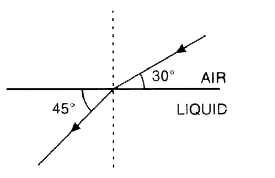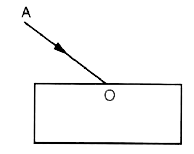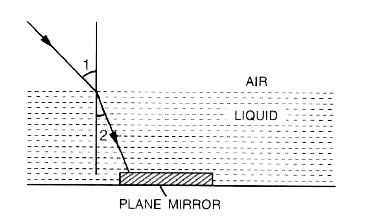Complete Solutions to EXERCISE-4(A) of chapter REFRACTION OF LIGHT AT PLANE SURFACES of Class 10 book with complete answers and questions
| Class 10 | PHYSICS |
| Chapter | REFRACTION OF LIGHT AT PLANE SURFACES |
| SELINA PUBLICATION | EXERCISE-4(A) |
| Number Of Questions | 31 |
| Academic Year | 2023-24 |
What do you understand by the term 'refraction of light'?
03:33View SolutionDraw diagrams to show the refraction of light from (i) air to glass, and (ii) glass to air. In each diagram, label the incident ray, refracted ray, the angle of incidence (i) and the angle of refraction (r).
02:39View SolutionA ray of light is incident normally on a plane glass slab. What will be (i) the angle of refraction, and (ii) the angle of deviation for the ray ?
01:55View SolutionAn obliquely incident light ray bends at the surface due to change in speed, when passing from one medium to another. The ray does not bend when it is incident normally. Will the ray have different speed in the other medium ?
00:53View SolutionWhat is the cause of refraction of light when it passes from one medium to another ?
01:52View SolutionA light ray suffers reflection and refraction at the boundary in passing from air to water. Draw a neat labelled ray diagram to show it.
03:24View SolutionA ray of light passes from medium 1 to medium 2. which of the following quantities of the refracted ray will differ from that of the incident ray speed, intensity, frequency, and wavelength ?
02:32View SolutionState the Snell's laws of refraction of light.
01:45View SolutionDefine the term refractive index of a medium. Can it be less than 1 ?
02:25View Solution(a) Compare the speed of light of wavelength 4000 Å (i.e., violet light) and 8000 Å (i.e. red light) in vacuum.
(b) How is the refractive index of a medium related to the speed of light in it and in vacuum or air ?03:08View SolutionA light ray passes from water to (i) air, and (ii) glass. In each case, state how does the speed of light change.
02:10View SolutionA light ray in passing from water to a medium (a) speeds up, (b) slows down. In each case, (i) give one example of the medium, (ii) state whether the refractive index of medium is equal to, less than or greater than the refractive index of water.
03:31View SolutionWhat do you understand by the statement the refractive index of glass is `1*5` for white light' ?
01:38View SolutionA monochromatic ray of light passes from air to glass. The wavelength of light in air is `lamda`, the speed of light in air is c and in glass is V. if the refractive index of glass is `1*5`, write down (a) the relationship between c and V, (b) the wavelength of light in glass.
03:10View SolutionA boy uses blue colour of light to find the refractive index of glass. He then repeats the experiment using red colour of light. Will the refractive index be the same or different in the two cases? Give a reason to support your answer.
02:24View Solution(a) For which colour of white light, is the refractive index of a transparent medium (i) the least, (ii) the most ?
(b) Which colour of light travels fastest in any medium except air ?06:13View SolutionName two factors on which the refractive index of a medium depends ? State how does it depend on the factors stated by you.
02:59View SolutionHow does the refractive index of a medium depend on the wavelength of light used ?
01:35View SolutionHow does the refractive index of a medium depend on its temperature ?
01:25View SolutionLight of a single colour is passed through a liquid having a piece of glass suspended in it. On changing the temperature of liquid, at a particular temperature the glass piece is not seen.
(i) When is the glass piece not seen ?
(ii) why is the light of a single colour used ?02:37View Solution
In Figure, a ray of light A incident from air suffers partial reflection and refraction at the boundary of water.
(a) Complete the diagram showing (i) the reflected ray B and (ii) the refracted ray C.
(b) How are the angles of incidence `i` and refraction r related ?01:45View SolutionThe diagram alongside shows the refraction of a ray of light from air to a liquid.
(a) Write the values of (i) angle of incidence, and (ii) angle of refraction.
(b) Use snell's law to find the refractive index of liquid with respect to air.
 02:24View Solution
02:24View SolutionThe refractive index of water with respect to air is `""_(a)mu_(w)` and of glass with respect to air is `""_(a)mu_(g)`. Express the refractive index of glass with respect to water.
01:30View SolutionWhat is lateral displacement ? Draw a ray diagram showing the lateral displacement of a ray of light when it passes through a parallel sides glass slab.
03:13View SolutionA ray of light strikes the surface of a rectangular glass slab such that the angle of incidence in air is (i) `0^(@), (ii)45^(@)`. In each case, draw a diagram to show the path taken by the ray as it passes through the glass slab and emerges from it.
02:22View Solution
In the adjacent diagram, AO is a ray of light incident on a rectangular glass slab.
(a) Complete the path of the ray till it emerges out of the slab.
(b) In the diagram, mark the angle of incidence (i) and the angle of refraction (r) at the first interface. how is the refractive index of glass related to the angles `i` and r ?
(c) Mark angle of emergence by the letter e. how are the angles `i` and e related ?
(d) Which two rays are parallel to each other ? Name them
(e) Indicate in the diagram the lateral displacement between the emergent ray and the incident ray. state one factor that affects the lateral displacement.07:06View SolutionA ray of green light enters a liquid from air, as shown in figure. Angle 1 is `45^(@)` and angle 2 is `30^(@)`.

(a) Find the refractive index of the liquid
(b) Show in the diagram the path of the ray after it strikes the mirror and re-enters in air. mark in the diagram the angles wherever necessary.
(c) Redraw the diagram if plane mirror becomes normal to the refracted ray inside the liquid.
state the principle used.07:57View SolutionWhen an illuminated object is held in front of a thick plane glass mirror, several images are seen, out of which the second image is brightest. Give reason.
05:51View SolutionFill in the blanks to complete the following sentence:
Q: When light travels from a rarer to a denser medium, its speed _____01:31View SolutionFill the blanks to complete the following sentence:
Q: When light travels from a denser to a rarer medium, its speed ______01:26View SolutionFill in the blanks to complete the following sentence:
Q: The refractive index of glass with respect to air is 3/2. thee refractive index of air with respect to glass will be _____01:13View Solution
EXERCISE-4(A) questions and complete solutions for chapter REFRACTION OF LIGHT AT PLANE SURFACES of SELINA PHYSICS (ENGLISH) of Class 10
